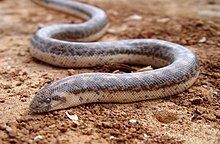The Erycinae, also known as the Old World sand boas,[1] are a subfamily of nonvenomous snakes in the family Boidae. Species of the subfamily Erycinae are found in Europe, Asia Minor, Africa, Arabia, central and southwestern Asia, India, Sri Lanka, and western North America. Four genera comprising 18 species are currently recognized as being valid.[1]
| Erycinae Temporal range:
| |
|---|---|

| |
| Javelin sand boa (Eryx jaculus) | |
| Scientific classification | |
| Domain: | Eukaryota |
| Kingdom: | Animalia |
| Phylum: | Chordata |
| Class: | Reptilia |
| Order: | Squamata |
| Suborder: | Serpentes |
| Family: | Boidae |
| Subfamily: | Erycinae Bonaparte, 1831 |
| Synonyms | |
| |
Description edit
Erycinae is a subfamily of stout-bodied snakes, all of which are competent burrowers. The largest, E. johnii, rarely exceeds 120 cm (47 in) in total length (including tail). Most grow to around 60 cm (24 in) in total length. They have small eyes and hard, small scales to protect their skin from the grit of sand. A great deal of sexual dimorphism exists, with females generally becoming much larger than males.
Erycines have skeletal adaptations to burrowing. The skull is more compact than in the subfamily Boinae. Also, the vertebrae of the tail are increased in size but reduced in number.[2]
Distribution and habitat edit
Erycines are found in Southeastern Europe, Asia Minor, North, Central, West and East Africa, Arabia, Central and Southwest Asia, India, Sri Lanka, southwestern Canada, the western United States, and northwestern Mexico.[3]
Fossil erycines have been found in rock strata over 50 million years old, and were once widespread in North America. Now, only four species remain in North America, as well as the Old World sand boas proper in Africa, Asia, and Southeastern Europe.
The oldest known erycines are from the Eocene-aged Messel Pit in Germany, named Rageryx schmidi.[4]
Behavior edit
The majority of sand boas spend much of their time basking below the surface of the sand, with only their eyes or head exposed. When potential prey approaches, they erupt out of the sand, bite, and employ constriction to subdue it.
Feeding edit
The erycines' primary diet is rodents, but they have also been known to prey on lizards and birds.
Reproduction edit
Otherwise far removed from their boine relatives, erycines are generally ovoviviparous, i.e., giving birth to live young. At least two species lay eggs, however: the Arabian sand boa, Eryx jayakari, and the West African sand boa, Eryx muelleri.
Smuggling and poaching in India edit
Poaching and smuggling of sand boas is often reported in India.[5][6][7][8] Most of the smuggled snakes go to the United States.[9][better source needed] There is a misconception about their medicinal and aphrodisiacal properties, as well as the belief that keeping this snake as a pet brings wealth and prosperity.[10]
Captivity edit
Eryx colubrinus, E. conicus and E. johnii are frequently available in the exotic pet trade and are often captive-bred. They breed readily, their small size making them an attractive option. They are usually not aggressive species, though they sometimes have a tendency to bite, and also spend the vast majority of their time hiding. Other species are not commonly available, but are occasionally imported.
Genera edit
| Genus[1] | Taxon author[1] | Species[1] | Subsp.*[1] | Common name | Geographic range[3] |
|---|---|---|---|---|---|
| Charina | Gray, 1849 | 2 | 0 | rubber boas | North America from western Canada south through the western United States into northwestern Mexico |
| EryxT | Daudin, 1803 | 13 | 2 | Old World sand boas | Southeastern Europe, North Africa, the Middle East and Southwest Asia |
| Lichanura | Cope, 1861 | 2 | 3 | rosy boas | North America from western Canada through the southwestern United States and into northwestern Mexico |
- Not including the nominate subspecies.
T Type genus.[3]
See also edit
References edit
- ^ a b c d e f "Erycinae". Integrated Taxonomic Information System. Retrieved 8 July 2008.
- ^ Goin CJ, Goin OB, Zug GR (1978).
- ^ a b c McDiarmid, R.W.; Campbell, J.A., Touré, T. (1999). Snake Species of the World: A Taxonomic and Geographic Reference Vol. 1. Washington, District of Columbia: Herpetologists' League. 511 pp. ISBN 1-893777-00-6 (series). ISBN 1-893777-01-4 (volume).
- ^ Smith, Krister T.; Scanferla, Agustín (2021-01-14). "A nearly complete skeleton of the oldest definitive erycine boid (Messel, Germany)". Geodiversitas. 43 (1). doi:10.5252/geodiversitas2021v43a1. ISSN 1280-9659. S2CID 231666355.
- ^ "Three held for trafficking rare snake species Three held for trafficking rare snake species". The Pioneer. India: CMYK Printech Ltd. 10 November 2011. Archived from the original on 10 May 2012. Retrieved 23 September 2022.
- ^ "The Hindu : States / Tamil Nadu : Sand boa caught near Dharmapuri". The Hindu. Archived from the original on 2011-01-04.
- ^ "Indore: Smugglers make crores with 'two-headed' snake". dailybhaskar. August 5, 2011.
- ^ "Sarpamitra, foresters bust racket selling sand boa - Times of India". The Times of India. 10 November 2011.
- ^ "Indian Sand Boa". www.kingsnake.com.
- ^ "Sand boa poachers eye big bucks". The Hindu. October 13, 2009 – via www.thehindu.com.
Further reading edit
- Bonaparte, Carlo Luciano (1831). Saggio di una distribuzione metodica degli animali vertebrati. Rome: Antonio Boulzaler. 144 pp. (Subfamily "Erycina [sic]", p. 67). (in Italian).
- Goin, C.J.; Goin, O.B.; Zug, G.R. (1978). Introduction to Herpetology. Third Edition. San Francisco: W.H. Freeman and Company. xi + 378 pp. ISBN 0-7167-0020-4. (Subfamily Erycinae, p. 319).
External links edit
Media related to Erycinae at Wikimedia Commons
- The Sand Boa Page at Kingsnake.com. Accessed 16 July 2008.